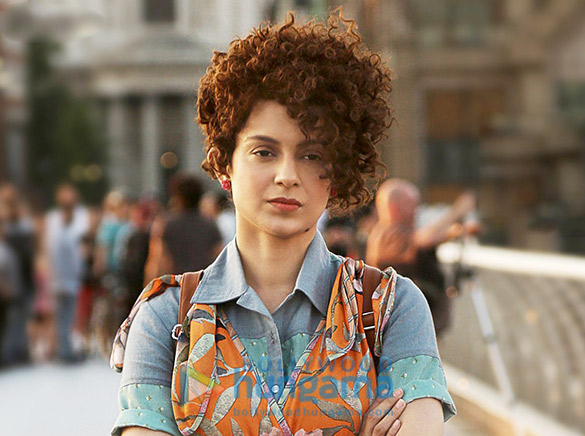A number of recent projects, headlined by major Bollywood stars reveal a sensitivity and awareness, likely prompted by the Modi government’s Mental Healthcare Act. But men, whose mental health figures are far more worrying, are shown as mentors and caregivers and support figures
In the Hindi film Judgemental Hai Kya (Are you Judgemental), something happened for the first time. The story is about a woman protagonist with several mental health issues—two of the conditions the film explicitly names are acute psychosis and disassociative disorder, but reviewers have pointed to symptoms of other conditions, an umbrella of disorders in effect. The star Kangana Ranaut, who plays the protagonist, is shown consulting with psychiatrists/counsellors and spending time in a mental health home. We see her taking her medicines, but also throwing them away sometimes, annoyed by the side-effects likely. But eventually, she cracks a murderer’s identity, and walks away jauntily owning the voices in her head, and presumably all the symptoms that her mental health conditions involve.
This has never happened in a Hindi film. For the past half decade or so, mental health conditions are being depicted with more care, more empathy, but they are cured/treated by film’s end. A mentally ill character has never been given an arc of acceptance where she/he claims their dissonance with pride and says this is who they are. In a beautifully realised sequence, Ranaut’s character walks down a road with all the voices/persons in her head, with the vim of a model walking down a ramp.

Something unusual, in fact, happened even before the film released: there was a protest against the film’s original title, Mental Hai Kya (Are you mental?). The term ‘mental’ is a colloquial use for someone who is not quite up there—covering a range of identities from eccentric or oddball to disturbed to dysfunctional (which might include criminal behaviour). It does carry derogatory implications, but it can also be good-humoured. What it certainly is not is a term of admiration. Take, for example, the term ‘PMSing’, used to indicate moodiness, annoyance or bad temperedness among women. It can be said good-humouredly but it is never a compliment. Mental health practitioners and activists protested the film’s title, arguing that it denigrated those with mental health issues and undermined decades of work to bring dignity and understanding to those suffering poor mental health. The filmmakers listened. Previously, film titles have only been changed when they involved caste insults—for instance, the Shah Rukh Khan produced film Billu Barber was changed to Billu when the community of barbers protested.
The Mental Healthcare Act 2017 counts as one of the Modi government’s most significant achievements. It gives every Indian citizen the right to access mental healthcare run or funded by the government, and most significant of all, assures that admitting a mentally ill person to a residential facility, or institutionalisation, would be avoided as far as possible. The objective is to enable persons suffering from poor mental health to live in “the community” as productively as possible. The Hindi film’s stock depiction of mental illness treatment until recently was the institution—from the Salman Khan films Tere Naam (2003) and Kyon Kii (2005) (a remake of One Flew Over the Cuckoo’s Nest) to Khamoshi (1970) with a whole lot of films in between. Before the Act was passed, there were nearly ubiquitous public service announcements on radio requesting people to stop the silence and stigma around mental illness and seek help. These messages were in Hindi and Bengali and English at least, the three Indian languages I know, likely in others too. The recent confidence of the mental health community—not only doctors and counsellors and social workers but also patients—stems from the Act. The legal provision is likely the reason why the producers of Judgemental Hai Kya agreed to change the title.
There is also the frankness of Deepika Padukone: In 2015, she spoke in a number of interviews with the press about her depression –the struggle to wake up and the roller-coaster of emotions during the day—and her reluctance to take medicines for the condition. “The counselling helped but only to an extent. Then I took medication, and today I am much better.” No public figure in India, leave alone a film star, had spoken in public about a mental health condition before this.
The Hindi film’s graph had begun to change around the same time. In 2014, there was Hasee Toh Phasee, where the heroine, played by Parineeti Chopra, suffers from an anxiety disorder. But she is a high-achieving intelligent and functional person, a post-doctoral scholar in Chemistry, who has returned to steal money from her father to fund her research work. This, too is resourceful, I thought, an expression of getting things done. The hero eventually falls in love with her, and they wed. Made on the budget of Rs 270 million, the film made Rs 980 million (official figures).

In 2017, there was Dear Zindagi, where the heroine played by Alia Bhatt suffers from an episode of depression that unsettles her life and career. Bhatt’s character is a successful film professional, with career prospects in the UK, an independent ambitious woman living alone in big city Bombay. Her psychologist is played by Shah Rukh Khan, who guides her to a realisation rooted in a childhood separation, and its happy resolution. This is the film that is most ostensibly about mental healthy, given that the therapist is the second most important character in the film and played by a huge star. Dear Zindagi did well at the box office, earning Rs 1300 million on a budget of Rs 300 million.
The same year, there was an intelligent indie called Phobia, made in the format of a horror film, where a young woman is diagnosed with agarophobia after a sexual assault. Agarophobia is the fear of going out, and on the advice of her counsellor, she spends some time alone in a flat staying indoors, and by implication journeying inwards with adventures that appear to erode her confidence. By film’s end, it is not clear if her agarophobia has gone completely but she does venture out again with a new show of artwork. She is apprehensive, but she is armed with a vision she did not know she possessed earlier. Once again, a happy sort of ending.
According to the 2015 data on suicides from the National Crime Records Bureau, the last year when such data was made available, there were 1,30,000 suicides in India, 68.5% of these were by men and 31.5% by women. Male suicides were more than double that of women. Around the world, men kill themselves in larger numbers than women do. If Hindi films give the impression that it is women who mostly experience mental health problems, the reality is the opposite. But this could also point to a different truth–that women are more likely to seek help than men do, and the Hindi film acknowledges this implicitly
Until a decade ago, the Hindi film had shown the mentally ill either incarcerated, and if free, as lunatic serial killers. The latter impression is largely thanks to the Bhatt camp of filmmaking which has produced Dushman, Sanghursh, Murder 2 and recently, Ek Villain. Many of these films did well commercially, others earned critical acclaim. Sometimes, this was coupled with an atypical sexual identity, such as a transgendered person or a crossdresser. This resulted in two problematic stereotypes—of the non-heterosexual identity and the mentally ill. This began to change a decade ago thanks largely to the filmography of Kangana Ranaut, who has an accomplished graph of playing characters with substance abuse, schizophrenia, depression and other problems.
What’s striking is that even in the recent batch of optimistic mental health portrayals, the experience of mental health problems is articulated through women, while men play supportive anchors or mentors. Even when male characters are clearly depressed or disturbed, they are seldom shown in treatment. The film Talaash (2012) shows this beautifully: both the hero and heroine played by Aamir Khan and Rani Mukherjee are grieving for the death of their son, but only the wife goes to a counsellor. The husband, meanwhile, stays up nights unable to sleep and broods alone—classic symptoms of depression. The counsellor asks the wife to bring the husband along and she stays silent. There is one film which explores the schizophrenia of a man, Karthik Calling Karthik, where the hero played by Farhan Akhtar receives phone calls from his alter-ego. But the film did poorly, both at the box office and with critics. Salman Khan has played troubled once in Kyun Kii… with disastrous box office results. Besides, this copy of One Flew of Over the Cuckoo’s Nest represents the older model of mental healthcare where patients are institutionalised.
According to the 2015 data on suicides from the National Crime Records Bureau, the last year when such data was made available, there were 1,30,000 suicides in India, 68.5% of these were by men and 31.5% by women. Male suicides were more than double that of women. Around the world, men kill themselves in larger numbers than women do. If Hindi films give the impression that it is women who mostly experience mental health problems, the reality is the opposite. But this could also point to a different truth–that women are more likely to seek help than men do, and the Hindi film acknowledges this implicitly.
This is why Judgemental is such a smart film: in addition to its happy ending, it suggests how the male mental health problem may be normalised, including criminal behaviour. In the midst of the colours and lustiness of Holi, a man’s manhandling of his wife is unseen though they both fall to their deaths. The blood looks like the colours of Holi. Characteristics that are seen as masculine—possessiveness, protectiveness, reserve, detachment, aggression—can conceal violence, and depression and poor communication in plain sight, in the garb of ‘men being men’.

When you look at it this way, you see how, for instance, a film like Kabir Singh camouflages the mental health problems of its protagonist. A man who abuses numerous substances, his patients, and the women in his life is seen as a tragic hero suffering incomplete love. This is how it is in the mother board of every Kabir Singh story, Devdas, and all its editions, too. Alcoholism, in particular, is seen as a suitably male response to any kind of suffering. In this sense, two films are interesting. In Aashiqui 2, Aditya Roy Kapur’s drinking has no reason in particular—he has a successful career in music, a father who seems concerned about him and calls him often on the phone, and a loving partner. He kills himself at film’s end. The film never mentions mental health, but suggests depression and addiction strongly. In Udta Punjab, Shahid Kapur has a similar arc—successful music career with a cocaine problem. All the junkies in the film have no particular reason for their addiction, at least the film does not explore them. It is presented instead as a Punjab problem. Haider does this too, actually—the “rotten” state of Kashmir is the undoing of Haider in a way that the rotten state of Denmark is not primarily the cause of the disintegration of Hamlet. The prince went mad because he thought his mother had murdered his father with the help of his uncle, the wound of an intimate betrayal.
For some reason, the madness of men is seen as the manifestation of larger political economic developments, or coping mechanisms for the wounds inflicted by women (the Devdas model) or unarticulated. The one film that dwells on the maladjustments of men at length is A Death in the Gunj, but this is actually outside the purview of this discussion because it is primarily an English-language film with the remaining tenth in Bengali. Largely, though, we have learned the stereotype of the “hysterical” woman so well that we don’t even see the maladies of men.
This essay was originally published in The Hindu Business Line’s weekend magazine BLink